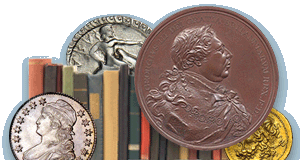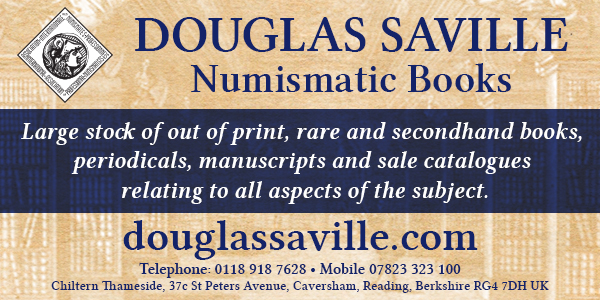
PREV ARTICLE
NEXT ARTICLE
FULL ISSUE
PREV FULL ISSUE
WYON FAMILY'S IMPACT ON COIN DESIGNSThe English Wyon family of engravers and medalists is responsible for some of history's finest coinage, and has had a significant impact on coin designs around the world. Here's an article by Zarine Parakh from the Heritage Intelligent Collector magazine. -Garrett As a family of medalists in the 18th and 19th centuries, the Wyons retain a legacy of prominent artistry. While there are Wyon family members with pursuits as varied as sculptor, architect, lawyer, and rector, their skills as engravers and medalists are what earned their fame. Heritage's August 27-29 ANA World & Ancient Coins Platinum Session and Signature® Auction features treasures from a trio of Wyons: Thomas, William, and Leonard. 

George III gold Pattern Sovereign 1816 PR64 Cameo NGC, by Thomas Wyon the Younger after Benedetto Pistrucci's model Thomas Wyon the Younger began his career as an apprentice to his father, Thomas Wyon, chief engraver of the king's seals, before continuing his studies at the Royal Academy in London. This proved successful, as Thomas became a probationer engraver for the Royal Mint at just 19. While he first created designs for bank tokens, he continued to hone his skills until 1815, when he was promoted to chief engraver. With the prestige of this position came responsibility, as he was chief engraver during the great recoinage of 1816. The 1816 piece on offer at Heritage is a gold Pattern Sovereign featuring the likeness of George III, engraved by Thomas based on Benedetto Pistrucci's jasper cameo of the king and the first of its kind to be offered by the auction house. Thomas' vibrant career was cut short in 1817, when he succumbed to consumption that September at only 25 years old. His brief career yet clear talent for engraving enhances the allure of his pieces, including the 1816 Pattern Sovereign available at Heritage, which further enchants due to its pondlike fields, razor-sharp devices, and harvest-gold glow. The history of this piece is palpable, as its incredible preservation teleports the handler back to the day it was struck during such a prominent year in numismatics. Thomas' father was an esteemed medalist himself, having gone into business with his brother, Peter Wyon, in Birmingham engraving tokens such as those in the Coventry series. Peter's son (Thomas' cousin) was William Wyon, arguably the most famous engraver of the family. William's life took a pivotal turn when Thomas Sr. invited him to London, where Thomas Sr. was working as an engraver for George III. William was awarded multiple prizes by the Royal Academy and the Society of Arts during his time in London, and in 1816 he secured the spot of second engraver, despite concern over his kinship with the newly appointed chief engraver, Thomas the Younger. The cousin duo overlapped at the Royal Mint for only a year before Thomas' death, after which Pistrucci was brought on full-time to fill the vacant role. During William's tenure as second engraver, which lasted more than a decade, he engraved dies for the Guanajuato mint's 8 Reales. These pattern pieces were struck at the Royal Mint in London before the coins and dies were sent to Mexico, where they would be seized at the port of Veracruz as contraband due to the Mexico City mint's monopoly on coin manufacture in the region. The design of these 8 Reales was inspired by the Mexico City version yet leaned into Wyon's preferred Neoclassical style. The rays of the Cap and Rays motif were shorter, fully encircling the Libertad cap, adding a whimsical feel to the iconic image. The silver Proof Pattern 1827 issue available at Heritage bears hallmarks of William's fervent attention to detail, which comes through in the bold strike and precise devices; the meticulous lettering used in the legends retains clarity as ornate denticles draw the eye around the design. One can hardly imagine a bewitching specimen such as this traversing the globe hundreds of years ago and yet remaining in near pristine condition. In addition to this incredible Pattern of 1827, Heritage is offering a Hermosillo Pattern of 1882, thought to be struck from William's dies over 50 years later.
In 1828 William became chief engraver in his own right, and his talent as an engraver spanned three British monarchs. He was commissioned in 1830 to design the coronation medal of William IV based on Francis Chantrey's bust. The Proof 1831 medal featured in Heritage's August auction is one of just 965 surviving gold pieces from the original 1,203 that were distributed at the coronation by the treasurer of the household or sold to the public by the Mint office and various Messrs. William also engraved the 1839 £5 "Una and the Lion," perhaps his most notable work, to commemorate the beginning of the young Queen Victoria's reign. Based off Edmund Spenser's poem The Faerie Queene, Victoria features as the titular character, Una, guiding a lion. Serving as an allegory to foretell the queen's success as a monarch, the lion is meant to represent the British Empire, with Una a representation of the Church of England. Seen as a masterpiece of British numismatics, the design melds the beloved English tale with the new queen's rise to power. It's a momentous visual in any grade of preservation, and Heritage is offering an unbelievable four Una 1839 £5 Proof specimens, including this Mint State representative. The opportunity to own such a beautiful yet controversial piece is scarce, sure to incite engagement when one considers this is the first time a monarch was depicted on coinage as a fictional character. 

Victoria gold Proof Sovereign 1839 PR65 Deep Cameo PCGS, featuring the young bust of the queen by William Wyon
William went on to serve Queen Victoria with his work on the "young head" bust design and the "Gothic" Crowns. Young head Proofs are now considered a symbol of Victoria's reign, certainly in no small part due to William's ethereal depiction of her. The bust was featured in Victoria's first Proof Set in 1839, which also included Una and the Lion. Heritage's August auction offers these Key Date pieces in veritable Proof and Proof Cameo grades, including this beautiful Gem masterpiece. William continued to create bold and magnetic coinage for the queen, next with his Gothic Crown. Minted in small numbers, the Gothic Crown is alluring in both rarity and historical value. William was at what could be considered the peak of his career, though during a turbulent time in British history, with the rise of the Industrial Revolution and Victorian Gothic. Tied to Romanticism, the Gothic style diverged from the Neoclassical and Georgian norms through its incorporation of architectural drama, intricate ornamentation, and the revival of medieval aesthetics. Marked by opulent, emotive, and mysterious motifs, this period saw the rise of spiritualism and interest in the occult. William encapsulates this moment of societal change with a dramatic design on the reverse of the Crown. One of this author's personal favorite types, a number of Proof Crowns are represented in Heritage's August auction, including this alluring near-Gem example. 

Republic gold ‘Coarse Beard' Burgers Pond 1874 UNC Details (Obverse Repaired) NGC, by Leonard Charles Wyon
A few years prior to the minting of these bewitching Gothic pieces, William's son, Leonard Charles Wyon, at the age of 17, also began work at the Royal Mint. Leonard was second engraver under his father for many years, up until William's death in 1851. Known primarily for his medals and overseas issues, Leonard engraved a number of dies for the British military and navy. He inherited his father's skill in portraiture, as seen in Leonard's representation of South African President Thomas François Burgers. The first coin of the South African Republic, the "Burgers" Pond was struck at Heaton mint in 1874. Leonard seemed to have a penchant for deep engraving, as dies would break and necessitate replacement. This is perhaps the case with the "Coarse Beard" and "Fine Beard" Burgers Ponds, as the first issues feature a finer beard, while the issues post die-break display coarse facial hair. Heritage is offering both varieties in remarkable preservation, transporting the viewer through time to the far corners of the British Empire. One of the most exciting parts of Heritage's ANA Platinum and Signature® Auction is the convergence of incredible numismatic and world history with the visual enchantment of elite craftsmanship and preservation. While here we touched on just a few of those histories through the lives and careers of the Wyon family, there are countless other stories waiting in the August 29 auction. Perhaps the next step in these masterpieces' histories will be finding a new home in your collection.
To read the complete article, see:
To read the earlier E-Sylum article, see:
Wayne Homren, Editor The Numismatic Bibliomania Society is a non-profit organization promoting numismatic literature. See our web site at coinbooks.org. To submit items for publication in The E-Sylum, write to the Editor at this address: whomren@gmail.com To subscribe go to: Subscribe All Rights Reserved. NBS Home Page Contact the NBS webmaster 
|










